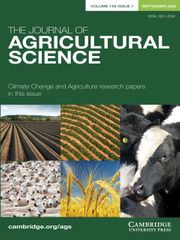Ver ítem
- xmlui.general.dspace_homeCentros Regionales y EEAsCentro Regional Santa FeEEA RafaelaArtículos científicosxmlui.ArtifactBrowser.ItemViewer.trail
- Inicio
- Centros Regionales y EEAs
- Centro Regional Santa Fe
- EEA Rafaela
- Artículos científicos
- Ver ítem
The role of homofermentative and heterofermentative lactic acid bacteria for alfalfa silage: a meta-analysis
Resumen
Lactic acid bacteria (LAB) are usually employed as alfalfa silage inoculants to obtain high-quality feed for animal husbandry. However, the effects of these inoculants are still unclear and need to be studied extensively. Therefore, the objective of this meta-analysis was to quantitatively summarize published research studies that assess the effects of homofermentative (HoLAB) and heterofermentative lactic acid bacteria (HeLAB) on fermentation parameters,
[ver mas...]
Lactic acid bacteria (LAB) are usually employed as alfalfa silage inoculants to obtain high-quality feed for animal husbandry. However, the effects of these inoculants are still unclear and need to be studied extensively. Therefore, the objective of this meta-analysis was to quantitatively summarize published research studies that assess the effects of homofermentative (HoLAB) and heterofermentative lactic acid bacteria (HeLAB) on fermentation parameters, nutritive value, microbiological composition and aerobic stability of alfalfa silage. PubMed, ScienceDirect and Scopus have been screened for articles published from 1980 to 2018. The criteria for inclusion were: randomized and controlled trials using alfalfa silage and published in peer-reviewed journals. It was found that inoculation with LAB decreased silage pH, neutral detergent fibre, acid detergent fibre and ammoniacal nitrogen, while it increased dry matter and crude protein compared to control in the pooled raw mean difference random-effect model. Additionally, LAB inoculation decreased acetate, propionate, ethanol and butyrate concentrations, whereas it increased lactate. In addition, inoculants reduced the counts of yeasts and moulds. Lastly, LAB inoculation improved aerobic stability. To the best of our knowledge, this is the first meta-analysis that aims at comparing the application of HoLAB and HeLAB for alfalfa silage. In the pool estimate, positive effects attributable to the application of microbial silage inoculants were found in most of the evaluated parameters; supporting the importance of applying both types of inoculants to improve forage preservation for the livestock industry.
[Cerrar]

Fuente
The Journal of Agricultural Science 158 (1-2) : 107-118 (March 2020)
Fecha
2020-03
Editorial
Cambridge University Press
ISSN
0021-8596
1469-5146
1469-5146
Formato
pdf
Tipo de documento
artículo
Palabras Claves
Derechos de acceso
Abierto
 Excepto donde se diga explicitamente, este item se publica bajo la siguiente descripción: Creative Commons Attribution-NonCommercial-ShareAlike 2.5 Unported (CC BY-NC-SA 2.5)
Excepto donde se diga explicitamente, este item se publica bajo la siguiente descripción: Creative Commons Attribution-NonCommercial-ShareAlike 2.5 Unported (CC BY-NC-SA 2.5)


